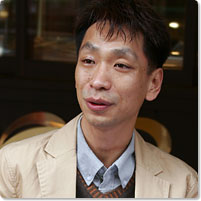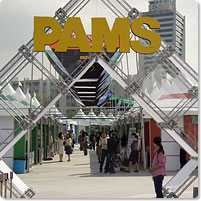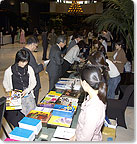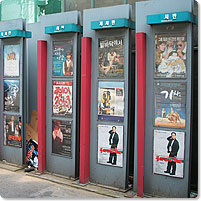- Isn’t it unusual for someone of your age (35) to be appointed director of the Korean Arts Management Service?
- Yes. I was surprised myself when the offer came, and I actually declined to accept it at first. Until then I had been directing the Seoul Fringe Festival (*1) and had often been a critic of the arts establishment from that position. This new job meant that I now had to be not just a critic of the status quo but take the initiative in doing positive things from the inside. It is a tense situation for me because now I am in the position of designer of the arts programs and, thus, the target of criticism inevitably.
- As a festival director you have been a spokesperson until now for young artists. What got you involved in the performing arts scene in the first place?
- I was active in theater circles in high school and college, and my dream was to become a TV or film documentary director. After I finished my military service I intended to study film at a vocational school, but as it turned out I got involved with an amateur theater company named SKENE that my college friends had started. So I remained in the theater scene. At the time, we had a lot of trouble getting around the unique Korean social establishment that effectively made it impossible for artists of our generation to rent a theater to perform in without the backing of someone from the older generation. It was not only me but many young artists who were having trouble with this system. So, we got together with artists from the music, art, dance, film and theater arts who gathered in the Hongdae (*2) area and we organized our own “Seoul Independent Festival” in 1997 as a platform to present our works to the public.
- Were you involved as the director from the beginning?
- No. At first I participated as an artist in the film field. But I happened to be involved in the organizing of a Women’s Film Festival and a Women’s Theater Festival for a couple of years at the Post Theater in Hongdae and in that way I became involved in the administrative side. It turned out that the administrative work was taking up so much of my time that I no longer had the time to work on film projects of my own. That is how I came to become involved in my present line of work, against my will (laughs). The Seoul Independent Festival changed its name to the Seoul Fringe Festival in 2002 and it continues today. This will be its tenth year and during this time I have had the opportunity to meet many festival directors from overseas festivals such as Japan’s Physical Theater Festival, the Bangkok Fringe Festival and the Hong Kong City Festival and I have experienced and learned a lot from these encounters. I think the reason I was chosen to direct KAMS was this experience in foreign exchange and my connections with these international festivals.
- Can you tell us about what kind of organization KAMS is and its role in the PAMS?
- KAMS was launched in January of this year. It is an organization under the umbrella of the Arts Policy Team at Arts Bureau of the Ministry of Culture and Tourism and it combines the Evaluation & Consulting Center for Certified Arts Organization, the Office of Asia Artplex and the Office of PAMS set up temporarily last year by the Ministry of Culture and Tourism. As an organization it is divided into three parts, a Planning Support Team, a Foreign Programs Team and the Office of Asia Artplex. Our work includes providing support for overseas performances by Korean performing arts groups and evaluation of federal support programs.
- I would like to ask you to describe the roles of these three parts of the organization in more detail. First of all could you tell us about your Planning Support Team?
- Our Planning Support Team continues the work that was being performed by the former the Evaluation & Consulting Center for Certified Arts Organization, which involves granting certification to companies in the specialized arts and evaluation of federal support programs. It is also involved in compiling information in the arts management area and providing consulting services for groups in the arts. So there is a total of four functions it performs. To explain the new functions simply, the arts management information function involves research and information compilation, the consulting branch is involved in consulting services in the areas of arts company operations and management and the training of personnel. How about the Office of Asia Artplex?
- The main jobs of the Foreign Programs Team are promoting international exchange and assisting the overseas activities of Korean artists. The operations are divided between Inbound and Outbound projects. Inbound involves introducing Korean artists to foreign presenters through venues like the PAMS, while Outbound involves publicizing Korean artists internationally through participation in overseas arts markets. Since we have just begun operations we do not have a clear picture yet about the scale of our budget in these areas, but at present a larger part of our efforts are going into the Inbound side. However, in the future we intend to shift more emphasis to the Outbound side.
- How about the Asia Art-plex Team?
- This is one of the “Central Cultural City Creation” programs that were begun during the previous presidency of Kim Dae Jung. Under this program city of Kyongju was designated as the Culture Center for the traditional arts of Kyongsangbukto province, Chonju the Culture Center for the traditional arts of Chollabukto province, Taegu was designated the “Fashion Design City,” Pusan was designated the Culture Center for film and video arts and Gwangju was designated the Asian Culture Center. The programs have already been established and are functioning in the first four cities and now we are concentrating efforts on the Asian Culture Center program in Gwangju. This is the Asia Art-plex program. Three years ago a special bill was passed for this program and an action group was formed under the direct supervision of the President. From now on, this will be one of the main programs that KAMS will be working on. Plans call for the opening of a new Asian Culture Complex in Gwangju in the year 2010. This complex will consist of an Asian Culture Network Center, the Asia Art-plex (arts creation center), a theater and a Children’s Museum.
- It seems that in recent year the government’s eyes are focused on the provinces domestically and on Asia internationally.
- Korea has a long history of conflict between the domestic provinces and during the previous presidency of Kim Dae Jung efforts were begun to dismantle the mechanisms and organizations that promoted this inter-provincial conflict. The city of Gwangju is the center of Kyongsangnamdo, a province that was long been alienated, from the rest of the country both culturally and economically, and it is also an area that continues to bear scars from the era of the democracy movement. So, I believe that there is special political significance behind the decision to designate Gwangju as the Asian Culture Center. Another factor is the recent government efforts to counter the tendency of centralization of everything in Seoul by promotion the division of government functions and shifting them to the regional cities. The Asian region has now achieved a certain level of economic growth and the government is definitely focusing now on South Korea’s role in Asia and our role as a cultural center of Asia, including phenomenon like the recent pan-Asian popularity of Korean TV dramas music and movies.
- It also seems that the South Korean government is actively providing more back-up for the domestic performing arts companies through such programs as support for their overseas performance.
- Yes. There has been some expansion of programs for introducing movies and music overseas, and I believe that we are now beginning to see the start of efforts to promote the performing arts like theater and dance as well. In fact, movies and music are relatively easy to promote because there are direct economic benefits. On the other hand, this is not the case with the performing arts. It is still an area where we are waiting to see more government support. This is another area where KAMS must play a role.
- Last year, the first Performing Arts Market, Seoul was held amidst big expectations in the performing arts world following when the creation of a special office by the government’s Ministry of Culture and Tourism. However, we have heard that there was considerable criticism about the size and contents of the market. This year KAMS will play the central role in organizing PAMS. Will there be any significant changes?
- Last year PAMS was organized with input from a lot of people but no unifying strategy. The may have detracted from the event as a whole. Based on last year’s experience, we have established clear strategy and concepts for this year’s market. The biggest difference is that the main venue has been moved from the National Theater to the Alco Theater on “University Street (*3) . As government backed institutions, it is certainly understandable that officials would want to make the National Theater or the Seoul Arts Center (*4) the venue for the market, but you can’t expect an effective event if it is held in a place like SAC that is a considerable distance from the performing arts scene and the flow of people in the city. This year’s budget is 770 million won (approx. 806,000 US dollar). Despite the fact that this is over 200 million won less that last year’s one billion won (approx. 1,050,000 US dollar) budget, I believe that we can expect a big positive effect from moving the venue to University Street. Also, despite the lower budget we have set ambitious goals to increase the number of showcases from 41 to 50, the number of overseas guests from 94 people from 22 countries to 120 people from 25 countries and the number of domestic participants to 3,000 and the total audience to 10,000. University Street has over 40 theaters. Do you have tie-ups in place with these private sector theaters and arts companies?
- There is no special tie-up agreement made, but the synergistic effect should be big. We have planned a University Street tour for our overseas guests, and I think the biggest of all will be the effect of having the market participants come to University Street and naturally get a picture of the Korean performing arts scene in that way.
- You mentioned that this year you have adopted a clear strategy and concepts. Can you be specific about what those are?
-
In terms of strategy, we have focused on the make-up of the foreign guests. We have divided the world into the seven regions of Western Europe, Eastern Europe, the Middle East, North America, Central and South America, Australia and New Zealand and Asia. And from these regions we have invited primarily producers from theaters and arts centers rather just festival directors. Taking the case of Australia for example, we will invite the representatives of the Opera House in Sydney, the Victoria Arts Center in Melbourne and the Performing Arts Center in Queensland. Our aim is to create a base that would enable a Korean company going to Australia to link together a tour that would include all of these cities. Until now the guests were mainly overseas festival representatives, which meant that most invitations ended up as a single performance in a single city, and it also meant that the timing was restricted to that of a particular festival. That means little return on the labor and investment made. Also, if you are dealing with theaters and arts centers the schedule can be set at any time during the year that best suits both parties, which opens up possibilities for other performances in the neighboring regions.
In terms of the market’s concept, the main concept this time is Asia. This is based on the decision that we are now in a time when we have to focus on Asia. One of the things that characterizes this year’s PAMS is that we are paying completely for all the guests coming from Asia, which means that they are being given financially priority compared to guests from other regions (*5) . Of course this is partly due the difference in economic conditions, but it is also because we feel a definite need to build a market in the Asian region. Because Asia is a region where we can build mutually beneficial markets. Also, in places like the U.S. and Europe the internal market is already formed, so rather than investing large amounts of money for the task of getting into those markets, by winning attention in markets in Asia, I think it can have a natural effect on markets in other regions. - Listening to you speak, it sounds like a much more logical strategy than what we might have heard from the older generation.
- The Korean performing arts world in now in a stage where the next generation is beginning to move in. The “PAMS Choice 2006” event that selected the showcase entries for this year’s PAMS was conducted by a program director system that involved experts in each field who were in their 40s or younger. In addition to making the system responsible for finding and selecting works that have the potential to be taken abroad, this system was also aimed at bringing attention to younger, more experimental works that might not have surfaced in the normal context of Korea’s cultural atmosphere as it is today. The result of this selection process based on the eyes of younger experts we selected a total of 25 works that reflect the diversity, progressiveness and contemporary relevance of Korean performing arts, including seven theater works, nine dance works, four music works, four multidisciplinary arts and one other.
- How do you view the current condition of performing arts in South Korea?
- Korean performing arts today are extremely diverse and full of creativity. In terms of diversity, if you consider the fact there are over 1,500 arts groups actively performing today and about 7,500 works are being introduced annually, I think you will see just how diverse it is. In terms of creativity, we are seeing the emergence of a third form of arts that creates contemporary works fusing aspects of traditional Korean arts along with Western methodologies. Despite this diversity and creativity, however, the distribution side of the market is still small, with only about 500 [producing organizations] operating domestically. The same is true overseas. Despite the fact that we have arts companies and works that definitely have the quality to compete abroad, we calculate that a mere 2.4% of them are introduced to foreign audiences. So, I believe that the current issue for the Korean performing arts is creating the mechanisms and venues for domestic and overseas distribution.
- Does overseas development mean primarily exchanges or opening up new markets overseas?
- I think we are in an age when exchange can’t be separated from economical aspects. Speaking in practical terms, economic [revenue] stability is essential for sustaining a performing arts company. If the economic situation is stable, reproduction is possible – in other words it gives you foundation to create the next work. However, because our domestic market is limited in size, we need to expand our market overseas. Artistically speaking, if you are only performing in the domestic market you tend to become like a frog in the well that knows nothing about the outside world. Expanding into foreign markets is also meaningful from the standpoint of mutual cultural development. Therefore, I think that both aspects are involved in real exchange.
- What do you think about the relationship with Japan?
- At the coming Performing Arts Market in Seoul, we have scheduled a ceremony to officially sign a program exchange agreement with the Tokyo Performing Arts Market. This is because our two countries are big mutual markets for each other. We intend to continue to actively pursue this kind of exchange in the future.
- Finally, would you tell us your vision of what you would like to see happening in the future?
- I want to do the very best job I can in my new role as the director of KAMS. My contract is for five years and during this term I want to create institutions and policies that are truly necessary and in the best interests of the artists. In other words, I want to have the political system working for the benefit of culture and the arts. And, in the areas of the performing arts scene where there is a need for a change of generations, I want to help see that there is more than simply a generation change. I want to work in ways that will bring about truly meaningful change.
Lee Gyu-Seog
Bringing Korean performing arts to the world scene

Lee Gyu-Seog
Born in Seoul in 1971, Lee Gyu-Seog dropped out of the Mass Communications course at Korea University in 1991. In 1997 he joined with other young artists in forming the Seoul Independent Arts Festival and eventually became its director. Known for such festival activities as a collaboration with the Chuncheon Mime Festival (2000 – 2001) programming the theater portion of the Gwangju Biennale (2002), and the Kachon Hamadang Festival Committee (2002 – present), Lee is also active internationally, participating in Japan’s Physical Theater Festival (2001) and Bangkok Fringe Festival (2002). He cooperates also in international exchanges at venues such as Singapore’s Asian Arts Market (2003) and the planning of the Seoul Focus Program of the Hong Kong City Festival (2005). Since January 2006 he has served as the director of the Korean Arts Management Service.
Korean Arts Management Service
https://www.gokams.or.kr/
(*1)
Seoul Fringe Festival: The Seoul Independent Festival that arose in 1997 quite spontaneously from the activities of younger artists changed its name in 2002 to the Seoul Fringe Festival. In 2005, some 308 groups and companies participated and total audience reached 170,000. Emerging from this festival have been artists like the popular rock band “Crying Nut,” director Ryu Sunbon of the film Crying Fist and the theater company “Notre.”
(*2)
Hongdae: This is the area of Seoul around the Hongik University. The area is known for its underground arts and their liberated atmosphere and as a center of youth culture where new culture is being born all the time.
(*3)
University Street (Taehangno): About 40 small theaters are concentrated in this area of Seoul and it is known as the trendsetting of new performing arts.
(*4)
Seoul Arts Center: This comprehensive arts complex in the Nambu district of Seoul includes Opera House, Music House, Hangaram Art Museum, Seoul Calligraphy Art Museum and Arts Library (Design Museum).
(*5)
Guests from the Asian countries will receive part of air fare and lodging and pay no participation fees, while guests from other countries must pay their own air fare.


2006 Performing Arts Market in Seoul (PAMS 2006)
Dares: Oct. 11-14, 2006
Venue: The University Street area of Seoul (Arko Arts Theater, Art Center Arko and other venues in the area)
Organizer: PAMS 2006 Board of Directors
Direction: Korean Arts Management Service
Support: Ministry of Culture and Tourism, Korean Arts Council
Cooperation: Seoul International Performing Arts Festival, Seoul International Dance Festival, Korean BESETO Committee
https://www.pams.or.kr/
© PAMS

University Street (Taehangno)
Photo: Noriko Kimura
Related Tags

